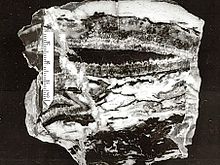Mud Mound

Mud Mounds are biogenic structures that consist mainly of fine-grained limestone ( micrite content more than 50%) that occur in the calm water of deeper basins, in lagoons or on submarine slopes. There are usually no larger organisms directly involved in the framework of the structure, although sponges and other animals and plants can be part of the mud mound ecosystem (in contrast to modern coral reefs , which consist of a coral framework and other skeletal organisms).
history
The term was first used for carbonate bodies in Florida Bay , the origin of which can be traced back to sediment-catching marine grasses. Epibiontic organisms on the grass ensure additional production of carbonate particles. Today the term is usually much broader.
Emergence
The following processes are mentioned for the formation of mud mounds in a broader sense:
- Enrichment of fine sediment by currents and waves
- local sediment deposits by sediment-collecting organisms
- Stabilization of sediment by encrusting organisms
- a thin coating of scaffolding organisms
- Cementation
Slumping structures are often observed on the flanks of mud mounds . Another characteristic of many Paleozoic Mud Mounds are the structures of cavities , so-called Stromatactis structures.
literature
- Erik Flügel: Microfacies of Carbonate Rocks. Analysis, Interpretation and Application 976 S., Springer Verlag, Berlin, Heidelberg, New York 2004 ISBN 3-540-22016-X (Mud mounds, S. 838)